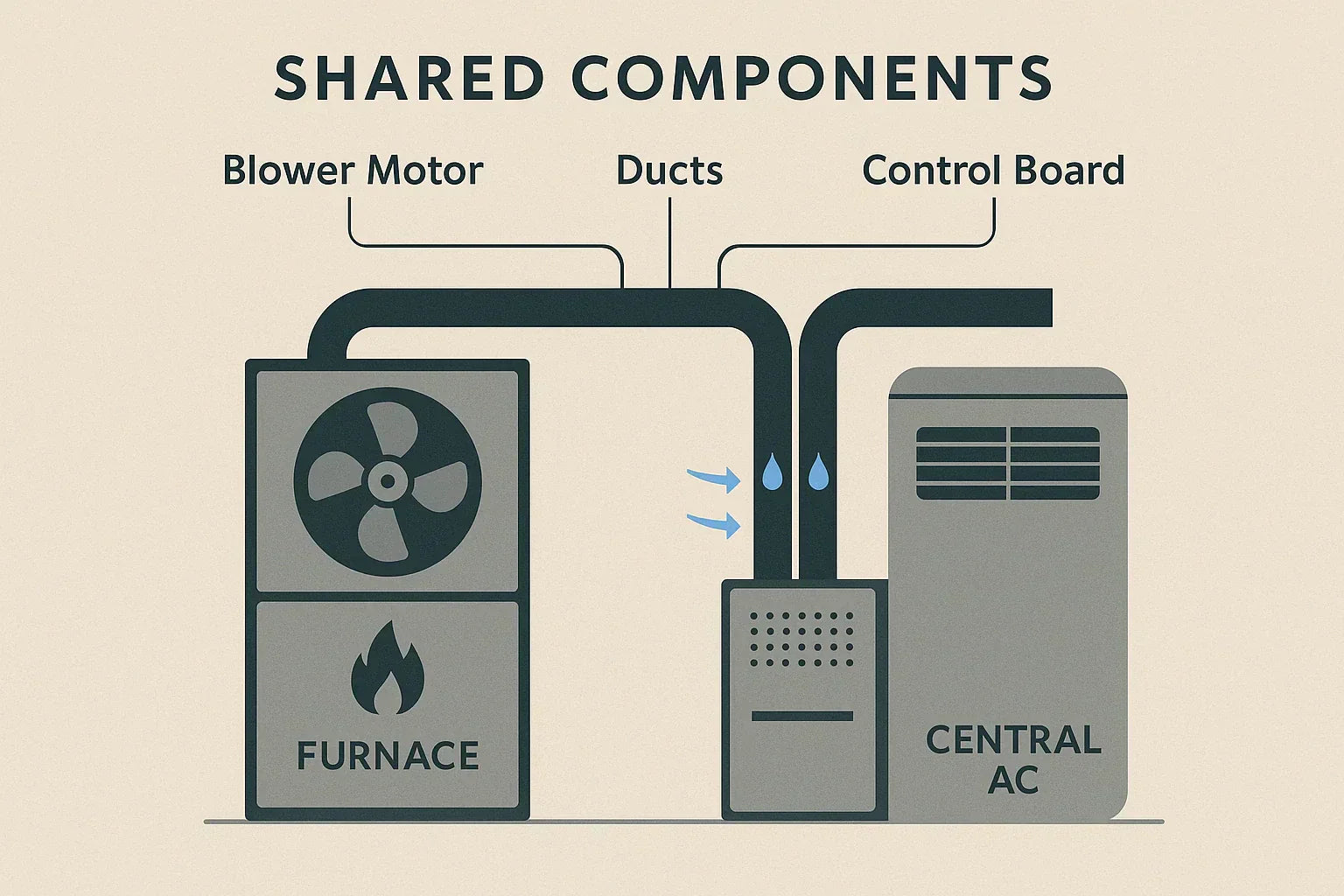Adding a new central AC is a big investment — and many homeowners wonder if they can save money by keeping their existing furnace. The short answer: yes, you can. But whether it’s a smart move depends on your furnace’s age, efficiency, and compatibility with modern cooling systems.
If you’re researching cooling options, our Top 10 Central AC Units Compared guide is a great starting point for understanding performance, features, and pricing across today’s best systems. In this article, we’ll zero in on whether you can install a central AC without replacing the furnace — and when it’s worth doing both at the same time.
How Central AC and Furnaces Work Together
In most homes, the furnace and central AC share key components. While the furnace handles heating, its blower motor also circulates cool air in the summer. This means:
-
If your furnace’s blower is outdated, your new AC may not reach its advertised efficiency.
-
The refrigerant coil for your AC sits on top of the furnace — so coil compatibility matters.
-
Your thermostat and ductwork need to handle both heating and cooling demands.
Energy.gov’s central AC guide explains that airflow, refrigerant coil sizing, and blower performance all play a role in overall system efficiency.
When You Can Keep the Furnace
Keeping your furnace is usually fine when:
-
It’s less than 10–12 years old and still in great shape.
-
The blower motor meets the airflow requirements for your new AC’s SEER2 rating.
-
Your ductwork is properly sized and sealed.
-
There’s no visible rust, cracks, or damage to the heat exchanger.
-
Your HVAC contractor confirms the coil and refrigerant line set are compatible.
If your furnace passes these checks, you could save thousands upfront by installing just the AC.
When It’s Better to Replace Both
Sometimes, replacing both the furnace and AC together is the better financial and comfort choice. Signs it might be time include:
-
Furnace age of 15–20 years or more.
-
A single-speed blower that can’t keep up with high-efficiency AC airflow demands.
-
Ductwork that’s undersized or leaky, wasting energy year-round.
-
You want to take advantage of rebates or tax credits that require matching efficiency ratings.
-
You’re already dealing with frequent furnace repairs.
According to ENERGY STAR, pairing matched systems maximizes efficiency and ensures both units are optimized for each other. This also often extends the warranty coverage from manufacturers.
Efficiency & Comfort Considerations
A mismatched furnace and AC can work — but it might not work efficiently. If the blower is too weak, your AC will struggle to circulate air, leading to:
-
Uneven cooling between rooms.
-
Poor humidity control in summer.
-
Higher electric bills.
Trane’s blower motor guide highlights that variable-speed blowers not only improve comfort but can help you hit the SEER2 performance your system is rated for. If your furnace doesn’t have one, you may never see the full benefit of your new AC.
Cost Implications
Replacing only the AC typically costs $4,000–$8,000, while replacing both furnace and AC ranges from $7,500–$15,000+, depending on size and efficiency.
But there’s a hidden cost to keeping the furnace:
-
If it fails in a few years, you’ll pay for a separate furnace replacement — possibly with another installation fee.
-
You might miss out on rebates from programs like the DSIRE incentive database that require matching systems.
-
Operating costs could be higher if your blower motor isn’t efficient enough.
A good contractor will calculate your total cost of ownership over the next 10–15 years, not just the upfront install price.
Warranty Considerations
HVAC manufacturers often prefer matched systems for warranty purposes. Some may reduce coverage or limit certain parts if the new AC is paired with an older furnace. Always read the fine print — or ask your contractor to check with the manufacturer directly.
Carrier’s energy-efficient air conditioning guide points out that while warranties are important, the bigger focus should be on long-term performance and efficiency. Choosing a system that works seamlessly together can keep operating costs low and comfort high for years.
Final Thoughts from Alex
As someone who’s been in hundreds of attics, basements, and crawl spaces, I can tell you: keeping your furnace when adding a new AC can be smart — but only in the right situations.
Here’s my quick rule of thumb:
-
If your furnace has 7–8+ good years left and runs efficiently, keeping it can save you money.
-
If it’s 15+ years old or has a basic single-speed blower, replacing both will almost always deliver better comfort, efficiency, and long-term savings.
The best way to know for sure? Have a licensed HVAC pro evaluate your furnace’s condition, blower capacity, and compatibility with the AC models you’re considering.
🔗 Next in this series: Top Central AC Units for Multi-Zone Comfort
Alex Lane
Your Home Comfort Advocate







